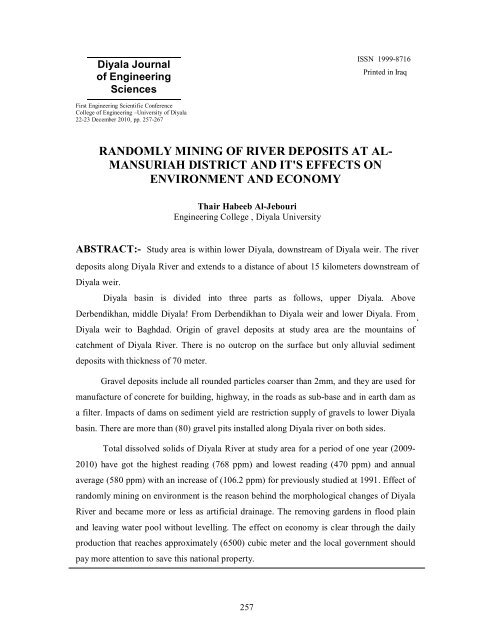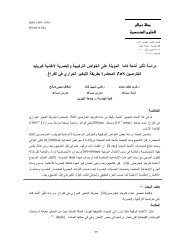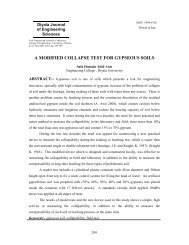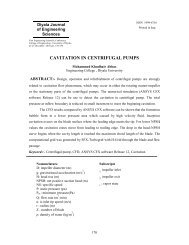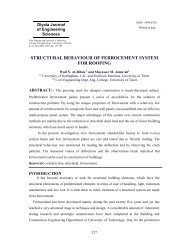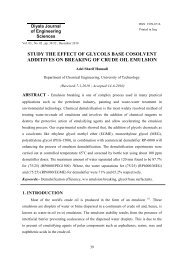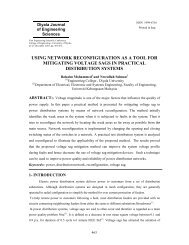Fulltext - Iraq Academic Scientific Journals
Fulltext - Iraq Academic Scientific Journals
Fulltext - Iraq Academic Scientific Journals
- No tags were found...
Create successful ePaper yourself
Turn your PDF publications into a flip-book with our unique Google optimized e-Paper software.
Diyala Journalof EngineeringSciencesISSN 1999-8716Printed in <strong>Iraq</strong>First Engineering <strong>Scientific</strong> ConferenceCollege of Engineering –University of Diyala22-23 December 2010, pp. 257-267RANDOMLY MINING OF RIVER DEPOSITS AT AL-MANSURIAH DISTRICT AND IT'S EFFECTS ONENVIRONMENT AND ECONOMYThair Habeeb Al-JebouriEngineering College , Diyala UniversityABSTRACT:- Study area is within lower Diyala, downstream of Diyala weir. The riverdeposits along Diyala River and extends to a distance of about 15 kilometers downstream ofDiyala weir.Diyala basin is divided into three parts as follows, upper Diyala. AboveDerbendikhan, middle Diyala! From Derbendikhan to Diyala weir and lower Diyala. FromDiyala weir to Baghdad. Origin of gravel deposits at study area are the mountains ofcatchment of Diyala River. There is no outcrop on the surface but only alluvial sedimentdeposits with thickness of 70 meter.Gravel deposits include all rounded particles coarser than 2mm, and they are used formanufacture of concrete for building, highway, in the roads as sub-base and in earth dam asa filter. Impacts of dams on sediment yield are restriction supply of gravels to lower Diyalabasin. There are more than (80) gravel pits installed along Diyala river on both sides.Total dissolved solids of Diyala River at study area for a period of one year (2009-2010) have got the highest reading (768 ppm) and lowest reading (470 ppm) and annualaverage (580 ppm) with an increase of (106.2 ppm) for previously studied at 1991. Effect ofrandomly mining on environment is the reason behind the morphological changes of DiyalaRiver and became more or less as artificial drainage. The removing gardens in flood plainand leaving water pool without levelling. The effect on economy is clear through the dailyproduction that reaches approximately (6500) cubic meter and the local government shouldpay more attention to save this national property.257
First Engineering <strong>Scientific</strong> Conference-College of Engineering –University of Diyala, 22-23 Dec. 2010RANDOMLY MINING OF RIVER DEPOSITS AT AL-MANSURIAH DISTRICT AND IT'S EFFECTSON ENVIRONMENT AND ECONOMYINTRODUCTIONThe river deposits along channel of Diyala river consists of all types of gravels andextended to a distance about 15 kilometers downstream of Diyala weir, (Fig-1) .Width ofgravel deposits include bed of channel and flood-plain area as well as river terraces on bothsides of Diyala river. These gravel deposits of good indication, which can be used as a tool toanalyze the climatic regime, type of rocks, and relief of catchments area. Gravel pits began atmid of nineteenth century on small scale nearby Diyala weir, but from beginning of 1970, theneeds for construction materials were increasing rapidly. So that many gravel pits andcrushing plants which are installed along Diyala channel, are only on right bank at that time.The gravel pits were controlled according to the laws and legislations of local authority andsupervised by geological survey which is responsible about regulation of mining operation.But during the last two decades and due to heavy exploitation of sediment deposits, manygravel pits became out of order, and looking for new areas becoming very necessary. For thisreason many new gravel pits are installed on both banks of Diyala river, after removing fruitplants without taking any care to environment and economy because of working inprohibition areas. In this research Diyala basin is divided into three parts as follows, upperDiyala:above Derbendikhan, middle Diyala: from Derbendikhan to DiyalaDiyala: from Diyala weir to Baghdad.weir, lowerORIGIN OF GRAVEL DEPOSITS AT STUDY AREAThe sources of materials of study area are the mountains and slopes which are situatedwithin catchment of Diyala river basin. The middle and upper Diyala basin is characterizedby high mountains with steep slopes so the depressions and vallies are covered by all types ofgravels. Since the scree materials or talus accumulate along mountain slopes as a result ofphysical action. So the amount of transported gravels from the source area to deposits placedepends on the flow energy of Diyala River especially during rainy season, when flood occurdue to precipitation. So the volume of transported sediments and volume of depositions areproportional to the intensity and periods of Diyala River flood. Sorting takes place, so that thecoarsest gravel is deposited nearby weir eventually.Diyala Journal of Engineering Sciences – Special Issue258
First Engineering <strong>Scientific</strong> Conference-College of Engineering –University of Diyala, 22-23 Dec. 2010RANDOMLY MINING OF RIVER DEPOSITS AT AL-MANSURIAH DISTRICT AND IT'S EFFECTSON ENVIRONMENT AND ECONOMYGEOLOGY AND GEOMORPHOLOGY OF STUDY AREAThere is no outcrop of bed or rocks appear on the surface at lower Diyala basin, thealluvial sediments deposits, are loosely compact and composed of pebbles at the channel bedand mixed of sand, silt and clay. At the banks the thicknesses of sediments are more than 70meters, detected from ground water drilling. These sediments are of Quaternary age,(Buday, 1980).At the beginning of lower Diyala basin near the wire, the wide of the river ischangeable, from 380 meters at the wire to 250 meters at a distance of 15 kilometers downstream. The river profile has slop of about 1.4 m/km until about 5-6 km below the wire,where the river soon enters the friable soils of the plain in which the regime slope appears tobe only 10 cm/km,(AL-Aansari and AL-Jabbari, 1987). Diyala River from the weir tillconfluence with the Tigris River, Southern Baghdad, flow in vegetative area, which isplanted by diffrint types of fruits. These field fruits are irrigated by Al-Khalis and Almushtriccanals or irrigated by using pumping method either from Diyala River or fromunder ground wells.RIVER DEPOSITSGravel deposits, represent the local accumulations of channel fillings, and riverterraces Stream deposits are the most common and generally most desirable because:Individual pieces are usually rounded;Streams exercise a sorting action which may improve grading; and 3) abration causedby stream transportation and deposition leads to a partial elimination of weaker materials,(Hilf, 1978). A gravel deposit consists of a frame works of pebbles between which are voids.The voids are rarely empty, being occupied by sand, silt or clay material. Clay also may forma coating about pebbles, surface coating generally reduce the value of gravels as concreteaggregate, this and/or soft and loosely adhering surface coatings are particularly suspect. Clayand gypsum coatings, however, can often be removed by screening and washing. The shapeand surface texture of the pebbles in a gravel deposits are influenced by the agent responsiblefor its transportation and the time taken in transport, although the shape is depends on theinitial shape of the fragment which in turn is controlled by the fractures pattern within theparental rock. Gravel particles can by classified as rounded, irregular, angular, flaky andelongated (Bell, 2007).Diyala Journal of Engineering Sciences – Special Issue259
First Engineering <strong>Scientific</strong> Conference-College of Engineering –University of Diyala, 22-23 Dec. 2010RANDOMLY MINING OF RIVER DEPOSITS AT AL-MANSURIAH DISTRICT AND IT'S EFFECTSON ENVIRONMENT AND ECONOMYoperated at 1980 the condition has absolutely changed due to deposition of whole load ofsediments at the reservoir of Hemrin dam, that the supply to lower Diyala basin wasrestricted.RIVER DEPOSITS USESSand and gravel are both needed for the manufacture of concrete for building andhighway construction. Sand is also used in mortar, which holds bricks and cement blockstogether, (plummer et; al; 2007). The sands which are using for making silica bricks or formanufacture of glasses should be almost pure quartz or the purities should be not less than95%.Sand and gravel are very essential in the construction of roads. They used as sub baseand on the latter stages they used in paving. Also the sand and gravels used in earth dam as afilter on shells while clay in core of dam and riprap as a protection in the upstream of dam.GRAVEL PITS AT AL-MANSURIAH DISTRICTIn a typical gravel pit, equipment for moving and utilizing gravels, like powershovels. Dragline, scrapers, bulldozers, bucket Wheel excavators, blade graders are used(Plate1). The material is dug from the face by a mechanical excavator, and this loads thematerial in to trucks or to a conveyer that transports it to the primary screening and crushingplant. After crushing, the material is further screened and washed. This sorts the gravel in tovarious grades and separates it from sand friction, (Bell, 2007). In study area, more than(80) gravel pits are installed up to now, located along Diyala river on both sides, beginningfrom Diyala weir and ended nearby the last village of sherween canal, for a distanceapproximate 15 kilometers in length and less than 2 kilometers in width.Many gravel pits had been shut down due to operating for along period in limitedarea. So the owners of these closed gravel pits start searching for new borrow area which islocated within the flood plain. These new area are already occupied by gardens, and investin these location will destroy the fruit plants and that’s what was happened. The gravels offlood plain are require special treatment before use because highly heterogeneous incharacter and the deposits covered with thick over-burden, which it has to be removedbefore mining (Singh, 1975). Also problem of water table in gravel deposits facing thedigging, because of gravels are highly permeable and the pits usually occurred under theDiyala Journal of Engineering Sciences – Special Issue261
First Engineering <strong>Scientific</strong> Conference-College of Engineering –University of Diyala, 22-23 Dec. 2010RANDOMLY MINING OF RIVER DEPOSITS AT AL-MANSURIAH DISTRICT AND IT'S EFFECTSON ENVIRONMENT AND ECONOMYlevel of the channel bed. So that it is easy to see a pool among gardens. After the end ofexploitation of the deposits the pits have been abandoned without dumping or leveling thatdue to highly cost.TOTAL DISSOLVED SOLIDS (TDS) OF DIYALA RIVER AT STUDYAREATotal dissolved solids, includes total positive and negative ions, it is measured bythe(ppm) or (mg/l) units. Concentration of the (TDS) in water of river influences by manyfactors, like type of rocks and soils in contact with it, human activities along and neabours towater flow, agricultures, artificial, drainage, nets, fertelizer of soil, and waste materials.Concentration of the (TDS) in water is a direct indicator to the water quality. Waterpollution is any things that degrade water quality. Surface water pollution is often bothhighly visible and of the most common threats to environmental quality (Cunningham,et,.al.2007).Chemical analysis achieved for water samples from study area for a period of oneyear (2009-2010) with monthly, sampling.The result of the highest reading was (768 ppm) and lowest reading was (470 ppm)with annual average (580 ppm). While the annual average of (TDS) of Hemrin reservoir andfor the same period (2009-2010) was (453 ppm). By comparism with result of previousstudy of the same station obtained from the same author, it was (473.8 ppm). That meansthere is increasing in (TDS) by (106.2 ppm), and that indicates the Diyala river becomemore polluted.EFFECTS OF RANDOMLY MINING ON ENVIRONMENT AT STUDYAREAThere are a lot of effects on environment at study area, some of them are due tomining, gardens removing and the other reason was due to the construction of dams. Sowhen the dams are constructed at the upstream of Diyala river .as mention before, as a resultof these dams, the water discharge to lower Diyala basin became under control. So that therewas no natural flood happened since 1980, except the large flood in 1988 and that was not anormal flood which occurred as result of rainy storm, but happened, due to criticalcircumstances at that time. The authorities of ministry of irrigation decided to cut andremoved the gates of Derbendikhan dam spillway and at same time the gates of Hemrin damspillway have been lifted, to protect Hemrin dam from failure. The water discharge to lowerDiyala Journal of Engineering Sciences – Special Issue262
First Engineering <strong>Scientific</strong> Conference-College of Engineering –University of Diyala, 22-23 Dec. 2010RANDOMLY MINING OF RIVER DEPOSITS AT AL-MANSURIAH DISTRICT AND IT'S EFFECTSON ENVIRONMENT AND ECONOMYDiyala was (4000) cubic meter/second, and lasted for 20 days. The regulation of dischargefrom Hemrin dam highly effected the morphology of Diyala river and started gradually tolose its character as a natural river, and became more or less as artificial drainage .The second reason was gravel pits and mining without taking care to the laws andlegislation which is legislated by local authorities and under the supervision of Geologicalsurvey. So the owner of gravel pits after digging and exploiting the materials from the pits,they left the overburden accumulated on side of Diyala channel and throw much of wastematerial to the river flow or near by the channel. In flood plain the excavated pits changed towater pools.The third reason was due to the cutting and removing of the gardens in Diyala floodplain and these gardens became places for gravel pits. So all the three reasons are behind ofenvironmental change at study area and it must be taken into consideration.EFFECTS OF RANDOMLY MINING ON ECONOMYTo estimate the amount of gravel materials in cubic meter, which is daily diggingand loading onto trucks from the whole gravel pits at study area, and to approach thisobjective, the following methods had been applied.The first method was by asking the owners of the gravel pits directly about amount ofdaily production and registered that weakly, to take the average production of each gravel pitindividually, and collect all the daily production of pits at study area. But this method wasunaffected and did not give a real quantity, especially when we do kind of comparingbetween the numbers of loaded trucks and the result of calculating data.The second method was selecting a check point which whole the loaded trucks passthrough it. Classified these loaded trucks according to their loads and recorded for wholeday and for one day a weak and for a period six months.The result of calculation was the daily average production of the gravel pits in studyarea 6500 cubic meter. So the local government should pay attention to such production, as anational property and to be sure whether all the gravel pits working according to the lawsand legislations or not. To take a wise steps to save this national property.CONCLUSIONS AND RECOMMENDATIONSDiyala Journal of Engineering Sciences – Special Issue263
First Engineering <strong>Scientific</strong> Conference-College of Engineering –University of Diyala, 22-23 Dec. 2010RANDOMLY MINING OF RIVER DEPOSITS AT AL-MANSURIAH DISTRICT AND IT'S EFFECTSON ENVIRONMENT AND ECONOMYMining of river deposits by more than 80 gravel pits ,situated downstream of Diyalaweir have been studied .The effect of gravel pits on environment are very conspicuouseither through deepening bed of Diyala channel which became isolated pools , by removingnatural sand bars within channel flow ,or on flood plain through cutting fruit plants andleaving pits without levelling. Effect of gravel pits on economy are clear through observingthe digging in prohibition area ,close to Diyala weir watching less than 3 Km and in floodpain without permission.On basis of mentioned above the following recommendations are suggested :1. strict on operation of digging and exploitation of gravels, and to control riverdeposits reserve.2. activation of supervision on production and places of gravel's exploitations.3. watch the steps of excavation and apply the laws and legislations which regulate andmanage the relation between the local government and the owners of gravel pits.4. emphasis on levelling all the pits within flood plain and encourage the farmers toreplant then.5. monitoring Diyala channel banks by all directorates which concerned withconservation of environment.REFERENCES1.Al-Aansari, N.T.et.al,1987 Al-jabbari,M.H.,1987 ,Hemrin Reservior,Geological andhydrological investigation, J.water Res.,special publication,No2.2.Al-Jebouri,T.H,1991. Hydrology and geomorphology of Diyala River Basin unpublished.Ph.D.thesis Univ. of Baghdad ,238p.3.Bell,F.G.,2007.Engineering Geology,. Elsevier publisher.2.Edi.4.Buday ,T., 1980.The regional geology of <strong>Iraq</strong> ,stratigraphy and paleotology ,Som Dar Alkitabpublishing house ,Mosul, 445p.5. Cunnigham,williamp.,cunningham,Mary.Ann.,Saigo.,B.,Woodworth.2007.,Environmental science ,A global concern ,McGraw Hill.6. Hilf,J.W.,1978 Design of small Dams.In united states Department of Interior, Bureau ofReclamation Oxford and lBH publishing Co.7. Plummer charles C.plummer.,carlso Diane H.,McGeary David,2007.Physicalgeology.McGraw Hill llength Edition.Diyala Journal of Engineering Sciences – Special Issue264
First Engineering <strong>Scientific</strong> Conference-College of Engineering –University of Diyala, 22-23 Dec. 2010RANDOMLY MINING OF RIVER DEPOSITS AT AL-MANSURIAH DISTRICT AND IT'S EFFECTSON ENVIRONMENT AND ECONOMY8. Reineck,H.E. and singh.l.B.,1980.Depostional sedimentary Environments, springer-_verlag pub, 2 nd Edition9.Singh Parbin, 1975.Engineering of general geology, katson pub.Fig.(1): Map of Study Area (After Al-Jebouri, 1991)Diyala Journal of Engineering Sciences – Special Issue265
First Engineering <strong>Scientific</strong> Conference-College of Engineering –University of Diyala, 22-23 Dec. 2010RANDOMLY MINING OF RIVER DEPOSITS AT AL-MANSURIAH DISTRICT AND IT'S EFFECTSON ENVIRONMENT AND ECONOMYa- Gravel pit at bank of Diyala river d- Excavation within Diyala flood plainb- Factory of cement brick at bank of Diyala river e- View of Diyala river-right bankc- Pool of water after excavation with flood plain f- Both banks of Diyala riverDiyala Journal of Engineering Sciences – Special Issue266
First Engineering <strong>Scientific</strong> Conference-College of Engineering –University of Diyala, 22-23 Dec. 2010RANDOMLY MINING OF RIVER DEPOSITS AT AL-MANSURIAH DISTRICT AND IT'S EFFECTSON ENVIRONMENT AND ECONOMYالتعدین العشوائي لترسبات نهر دیالى في ناحیة المنصوریة وتأثیراته البیئیة والاقتصادیةالخلاصةتقع منطقة الدراسة ضمن حوض دیالى الأسفل بالقرب من ناظم دیالى وتمتد المسافة 15كم أسفل ناظم دیالى وعلى امتدادمجرى النهر. قسم حوض دیالى في هذا البحث إلى ثلاث أقسام وكما یلي :حوض دیالى العلوي ویشمل مناطق أعاليدربندیخان وحوض دیالى الأوسط: یشمل المناطق المحصورة بین دربندیخان وبین ناظم دیالى، أما حوض دیالى الأسفل:یشمل المناطق المحصورة بین ناظم دیالى ومدینة بغداد.مصدر الترسبات النهریة في منطقة الدراسة هي المناطقالجبلیة الواقعة ضمن منطقة التغذیة لنهر دیالى ،وتنعدم فیها المكاشف الصخریة على السطح وتظهر الترسبات النهریةفیها فقط ویصل سمكها إلى 70 كم وتشمل الترسبات النهریة كل المواد الحصویة والرملیة والتي تنحصر أبعادها أكثر من2ملم وتستخدم في صناعة الكونكریت لغرض المباني والطرق السریعة وفي أسس الطرق والسدود الترابیة. یوجد في منطقةالدراسة أكثر من 80 مقلع على امتداد نهر دیالى والمسافة 15 كم وفي كلا الجانبین والدراسة انحصرت في الجانب الأیمنمن النهر. التحلیل الكیماوي لمجموع المواد المذابة في نهر دیالى ولمدة سنة كاملةقراءة(768ج .م .م(2010_2009)وأوقل قراءة (470) ج .م .م) وكمعدل سنويوبزیادة قدرها ( .م .م (580 جكانت كما یلي أعلىمقارنة بدراسة سابقة ولنفس الباحث علما إن المعدل السنوي لمجموع المواد الذائبة في بحیرة حمرین ولنفس المدةً(106.2 ج.م.م)2009)( . .م.م 453) ج كانت (2010_د. ثایر حبیب الجبوريأستاذ مساعدكلیة الهندسة جامعة دیالىالتعدین العشوائي للترسبات النهریة ولعدم مراعاة القوانین والتشریعات الخاصة بالتعدینوالمشرعة من قبل الحكومة المحلیة و تحت إشراف هیئة المسح الجیولوجي وكان السبب في أحداث تأثیرات بیئة مهمةعلى نهر دیالى ,منها فقدان النهر لخواصه الطبیعیة وتحوله إلى ما یشبه المنزل الاصطناعي نتیجة إزالة البساتین التيضمن الحوض الفیضي وتعدین الترسبات التي فیها وتركها بعد التعدین على شكل برك مائیة دون إجراء تسویة لها. إماالتأثیرات الاقتصادیة فتتمثل فیما تنتجه هذه المقالع من كمیات من الحصى والرمل وبمعدل یومي یصل إلىمتر (6500)مكعب فقط من منطقة الدراسة وبما أن هذه الترسبات هي ثروة وطنیة فیجب على الحكومة المحلیة وهیئة المسحالجیولوجي إن تأخذ الموضوع بنظر الاعتبار والحد من التجاوزات الغیر قانونیة.Diyala Journal of Engineering Sciences – Special Issue267


